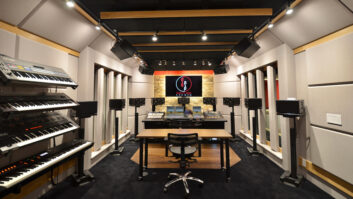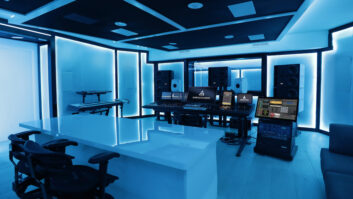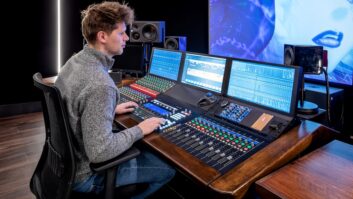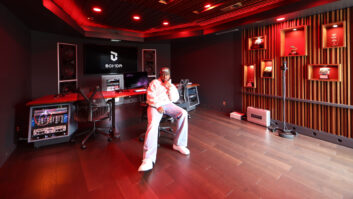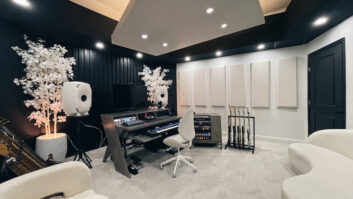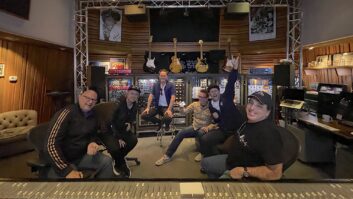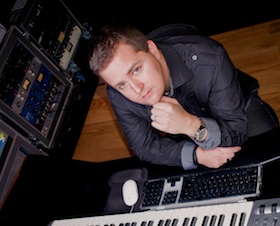
Andrew Dawson
With two Grammy Awards, five nominations and credits on dozens of Number One and Platinum albums and singles, mixer/engineer/producer Andrew Dawson has accomplished more at the age of 29 than many accomplish in decades in the profession. While the story of his rise to success is part and parcel of the age-old “being at the right place at the right time” phenomenon, it’s also proof that to make it in today’s industry, one must possess a perfect fusion of skill, personality and desire.
Dawson working at Avex (Hawaii)
NATURAL PASSION
For Dawson, music became a regular and integral part of life at the age of 5, when he began learning to play the piano. From then until the age of 16, he studied the instrument at a private music conservancy. Even though the majority of the music he studied fell into the classical and jazz genres, Dawson’s heart was always drawn to rock, hip-hop and modern pop music. Fortunately, his classical training provided him with a solid framework for playing these styles of music, which would play a role later in his career. However, performing wasn’t Dawson’s true aspiration. During his teenage years, he developed an intense interest in mixing. This interest skyrocketed after he obtained an early version of DAW software, and at that point there was no turning back.
When Dawson was a senior in high school, he managed to earn enough credits to attend classes until just noon each day and spend the second half of his day as an intern at a Minneapolis recording studio. “I was the coffee boy, the sandwich boy and the clean-up boy,” Dawson says, “but it was a really cool experience. I loved being in that environment, especially given that I was just 16 years old.”
Dawson at the Record Plant (L.A.)
Dawson enjoyed the experience so much that he spent his summer doing live sound for the City of Minneapolis at outdoor concerts. “There would be 400 to 500 people at these concerts, so it was pretty significant,” remembers Dawson. “I still don’t know why someone would give a 16-year-old this type of responsibility, but I was grateful for the opportunity and I was really able to cut my teeth through the experience.” This experience proved significant in his days at Berklee College of Music, where he would majored in piano. While there, the live sound gigs he landed helped pay the bills, and the work he did for a studio record label helped him pay his dues. “I remember having to drive for hours and hours running CDs to different record stores around Minneapolis,” says Dawson. Though it was hard work, Dawson was meeting people and demonstrating his drive and determination to his superiors.
Back at Berklee, Dawson’s musical horizons were expanding exponentially, as well. His continued exposure to the rock and pop worlds provided him with opportunities to perfect playing different types of music and offered him a platform for dabbling with other instruments. Still, Dawson’s focus remained one-directional, and that, coupled with long hours and sheer determination, were beginning to pay off. By the time Dawson was 21, he landed a job at Lexicon, the company that designed the world-renowned 960L reverb. Not long after, Dawson’s career would receive a significant boost when he was offered a staff engineer position at Sony Music Studios in New York City. His ambition and acquired skills had gotten him to a crucial point in his career, but would it be enough to sustain him?
An inside look at Dawson’s control room inside his StudioEQ
SETTING HIMSELF APART
According to Dawson, talent and connections will only get you so far. In many cases, personality is key to getting to the next level in the music business—and keeps you there. Fortunately, these were traits that fell comfortably in Dawson’s wheelhouse, and it was this mixture that allowed him to begin to make a name for himself. Word quickly spread about Dawson’s mixing chops and his confident but easy-going, gracious demeanor, and in a short amount of time, a steady stream of serious talent had become regular clients. The success prompted a move to the West Coast, work at major studios in Los Angeles (Glenwood Place Studios, Chalice Studios, ), in New York City (MSR Studios) and Hawaii (Avex Honolulu); projects with such A-listers as Kanye West to T.I. to Destiny’s Child; and, ultimately, the launch of his own studio, SoundEq.
Since then, just a few of Dawson’s long list of credits has included serving as mixer and engineer on Kanye West’s Platinum and Billboard Number One album My Beautiful Dark Twisted Fantasy; serving as engineer on Rick Ross’ album Teflon Don, which went to Number 2 on the Billboard Top 200 chart; and serving as mixer and engineer on Lil Wayne’s triple-Platinum, Number One album Tha Carter III. And it doesn’t look like things are going to let up any time soon. In addition to still working with his current clients, Dawson will soon produce Rapper P.O.S., among others.
“I think there is a certain amount of luck involved in my success, but the truth is, a lot of people are given lucky breaks,” says Dawson. “It’s what you do with the lucky breaks that come your way that set you apart. I was fortunate enough to be able to capitalize on mine by doing the best that I could do on every project that I was given, and I think that is what is largely responsible for what I’ve been able to do.”
Dawson’s philosophy of doing business is also centered on humility. “I don’t care if a client is big or small, a mega-star or just starting out,” he says. “I always treat each with the same amount of attention and respect. Some mixers and engineers make it more about them than the client. That’s just not my style.”
Dawson working with Kanye West
TECHNICAL PROWESS
In fact, for Dawson it’s all about the client. “Whenever I work with someone new, I will do my homework and listen to material they’ve done in the past and find out more about them,” says Dawson. “I also ask a lot of questions in my initial meetings with artists and find out what they’re listening to, what inspires them and how they hear certain types of music. Essentially, I want to get inside their head and figure out what strikes them so I can get a gauge on where I need to go sonically to capture their vision.”
Dawson working at Kanye West’s pad
After working with an artist, Dawson also takes note of their likes and dislikes so they are comfortable the next time they record. “If you can remember how an artist liked to record his vocals, he’ll remember that and appreciate that you have taken the time to know his preferences,” he says. “If you can be seen as an asset to the artists you work with, they are more likely to call on you for the next project.” He also stresses the importance remembering that the job of a mixer or engineer is to help the artist shine, not yourself. “The general public is not going to buy a record because it was mixed by so and so; they’re buying a record because of the artist. It’s not about you as a mixer or engineer, and it’s important to keep the big picture in sight.”
Dawson working with rapper Common
Of course, it’s also important to be ready to bring something new and different to each project. That said, Dawson’s willingness to push the sonic boundaries of pop and hip-hop have certainly served him well. “I don’t like copying styles; I really push myself as a mixer and producer, and always try to make sure I’m not becoming stagnant in my approach so I can avoid becoming formulaic,” says Dawson. “I don’t go into the studio, and say, ‘I’ll just use this preset on his vocal because it worked before.’ I approach every song as a unique entity, and I think being willing to try something new and different every time and do whatever it takes—whether it’s technically ‘correct’ or not—has been very beneficial to me as an engineer.”
What’s also helped is Dawson’s aptitude to adapt to the various studio environments in which he’s called to work. “My job involves a lot of bouncing around from studio to studio, so I have had to learn to be flexible,” he says. “You can get really comfortable working in a particular studio, but then when you have to go to another, you may have to deal with a totally different sound or assistants that may not be the best, and you have to quickly be able to adapt and pick up the slack because the client doesn’t care what you have to go through; they just want a great product.”
Dawson working with Common
Back at SoundEq, Dawson is able to generate great products partially because of the effective setup he’s created. While he says he has the room to put in a board, in light of the fast-paced nature of his production regimen—rom producing to mixing to editing to radio editing—he simply doesn’t have the time to deal with a board and relies, instead, on Avid Pro Tools and other resources. “I get great sonic results that parallel an analog setup with the key pieces of equipment I have,” says Dawson. These key pieces include Avid Pro Tools HD3 Version 9; Logic Studio 9; Lavery and Apogee converters; Euphonix MC control surfaces; Sound Toys and Massey plug-ins; Neve, custom-built pre’s; SSL, Tube-Tech CL-1B and dbx 165 compressors; and Empirical Labs Distressors. “I’m really happy with the setup I have,” says Dawson, who admits he hasn’t gone to Pro Tools 9 just yet simply because he hasn’t had enough downtime to make the switch.
A WORD OF ADVICE
To all those mixers and engineers whose dream it is to follow in Dawson’s footsteps, he offers this guidance: “It may seem obvious, but I have to say that it’s going to take a lot of hard work. There is no easy way to make it, and it won’t get dropped into your lap,” says Dawson, who says he was living and breathing equipment and sounds for years and still does to a certain degree. “If you decide to pursue this career path, you’ve got to give 100,000 percent, be willing to try to make every client’s project have its own unique sound, learn how other producers and mixers and artists think, and keep what you do in perspective.”
While Dawson has certainly enjoyed the fruits of his labor, even he has not been above the sharp fluctuations that have defined the industry of today. “I’ve definitely had to adapt to smaller budgets and all of the changes that are occurring,” he admits. That aside, he has no complaints. “Being able to go to work every day and do what I love is the most gratifying part of my career. I work with really talented people who genuinely enjoy what they do. No one I work with is just showing up and punching a clock; they are doing what they love to do, and the great energy that results is one of the coolest parts of my job.”
PopMark Media is a creative partnership developed to help music industry professionals, filmmakers, advertising agencies and business professionals make sense of the changing requirements, develop effective strategies and stand out in a sea of competitors. The company offers innovative and personalized services that include a full range of promotional, social media and strategy consulting; original music composition, jingle production and music supervision; and sound polishing services for various projects.
Studio Unknown is full-service audio post-production facility that specializes in helping clients discover creative sound for film, video, Web, gaming and artist projects.
